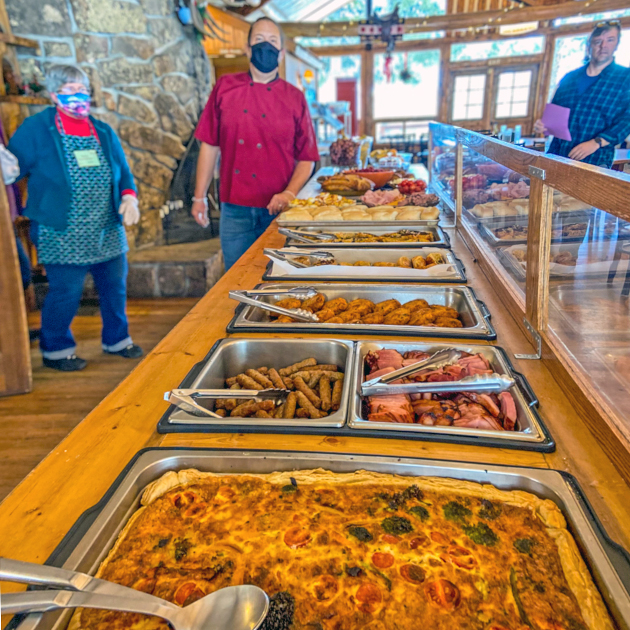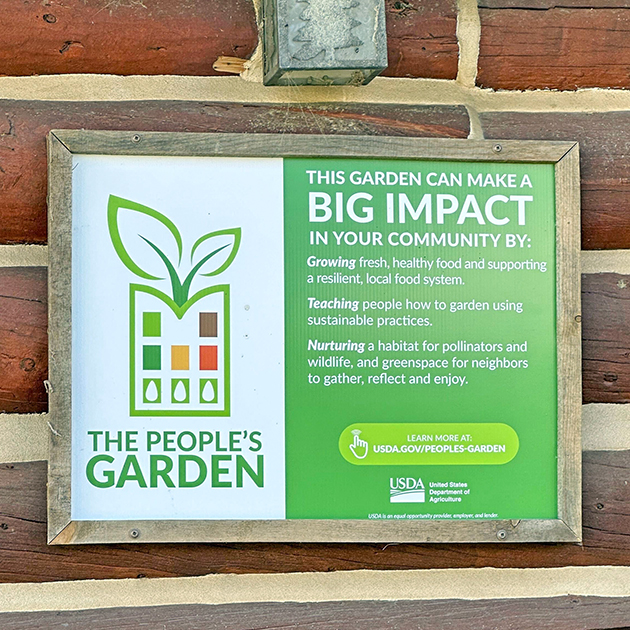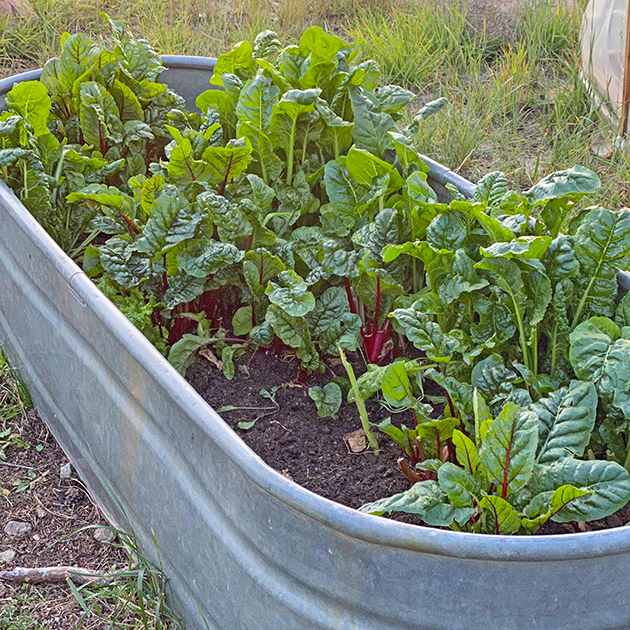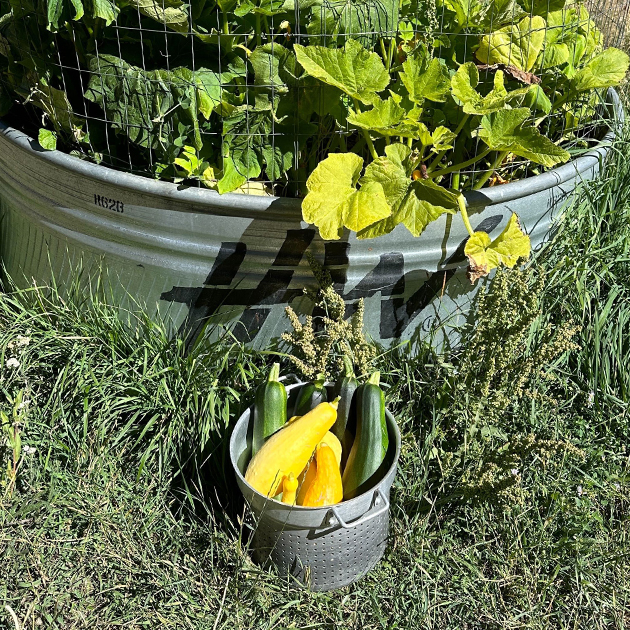Kitchen Talk: What’s New with Food at the A/U Ranches?
A Q&A with Matthew Leon, Director of Food Operations & Head Cook, A/U Ranches; and Mike Kilborn, Assistant Director of Food Operations & Head Cook, Round-Up Ranch
Matthew and Mike are well known at the A/U Ranches for the delicious food they prepare and the loving way they communicate about it to campers of all ages. They also have mad skills in food efficiency and gardening. Zipline spoke with them recently about improvements in food management at the A/U Ranches and vegetable gardens planted on the property.
In 2020, the dining halls switched from an open buffet to a catered line at meals. What effect have you seen on food waste as a result of this change?
Mike: Post-service food waste – after food leaves the line – is unquestionably lower than when we served as a buffet. This is evident daily by the weight of the trash cans in the scraping areas alone. Not only are they lighter, they are a lot lighter, which translates to people eating more of what’s on their plate.
Matthew: For the buffet, we have to put out a lot more food. It’s a reduction in wasted food and how much we’re cooking.
|
Mike: Serving from the line, rather than buffet, has also allowed us to keep a closer eye on making sure people are eating properly. This is especially important during Youth Camp. It gives us an opportunity to see what kids are eating or not eating, and to see if we can find something for them, or to make sure they aren’t walking away from the line with a pile of bacon and nothing else. In a buffet, it’s much harder to notice such things.
The serving line also allows us to cook more accurately for the number of people we have. We’ve taken other steps in that area too, trying to get accurate numbers to reduce waste and cost.
Matthew: From 2019 to 2023, U.S. food prices rose by 25%. We’ve weathered inflation and market price fluctuations in pork, poultry, and eggs – and the increases in transportation costs – by keeping food costs down, serving what we want by not making as much. During the summer, in 2019 the average food cost per meal per person was about $4.23. In 2024, we project that amount will be $5.04.
What happens to the food after it leaves the line?
Mike: We donate a fair amount to Arkansas Valley Christian Mission. While dropping off some food a few months ago, I asked them how much of what we give gets used. They said something in the range of 80%-85% goes out either in their weekly meals or out of their pantry for home use.
|
Matthew, you’ve planted two People’s Gardens. What are they and why did you plant them?
Matthew: I love vegetable gardening, and it came as a natural way to put to use a couple spare pieces of land that were getting neglected.
The USDA’s People’s Garden is designed to give attention to small community gardens and educate the public. I registered the gardens to put the A/U Ranches on the map. It shows the public what else the organization is doing and brings visibility to camp.
We have two independently recognized People’s Gardens. The larger garden is behind Chuckwagon and the other is a smaller kitchen garden located in front of the Valerie Lodge kitchen – it makes use of smaller containers and a narrow retired water tank. We also planted sunflowers in a retired water tank and potatoes in an old canoe – we pulled a bushel of potatoes out of the canoe!
|
We employ various gardening concepts in our People’s Gardens. The African keyhole garden is a technique that continuously replenishes the soil as crops grow. It’s named for its unique shape, a cinch within a circle with the inner sphere being a tower or vessel to create compost. Around the tower, there is a larger circle that creates the garden bed. There is an opening notch in a section of this larger circle that’s used for access to the middle composting tower. When this is viewed from overhead, it looks like a keyhole. Here at the Ranches, we make use of the concept without the visual cue of a walkway that would form the keyhole shape.
|
We also use hügelkultur, which involves wood waste such as branches, cut log ends and stumps that are either piled up on the surface or placed in a trench in the ground. On top of this wood material we pile other organic matter such as hay, straw and grass clippings. On top of this we then pile aged compost and topsoil to plant in. The wood core breaks down over time and becomes a spongy mass that helps hold and regulate water for the developing plant life on top. This is especially helpful in dry climates like Colorado. The wood and other organic matter continue to break down and release nutrients that feed the developing plants over many years.
Permaculture, regenerative agriculture, biodynamics and holistic management all govern our gardening methods.
Gardening also helps make use of all the compost we produce from kitchen trimmings. We only compost vegetable waste and occasionally egg shells – not post-consumer waste. In addition to traditional composting, we do vermicomposting. A few thousand red wiggler worms and European nightcrawlers break down vegetable scraps in four bins, even in cold weather. Composting our vegetable waste reduces trash volume in our dumpsters substantially each week. During the summer we divert two to six 5-gallon buckets of waste from the landfill daily.
What effect, if any, are you seeing from having fresh vegetables grown on the property?
Matthew: It definitely provides opportunities for participant engagement. An example of this is when I harvested our sugar snap peas and brought them to our 100 Elk group from Crestone. The kids swarmed me and grabbed handfuls as if they were candy! It was tons of fun. That group has a school garden, and they knew how good truly fresh snap peas are. We serve greens daily at breakfast and I made the squash into a dinner entree. I still have onions in the ground and am curious if they will overwinter to become full-size onions this season.
Community members volunteer and take part in planting and harvesting each season.
|
What do you plan to plant in 2024 and when? Do you start with seedlings inside?
Matthew: I start with seeds in the open ground once the threat of freezing is over (Memorial Day weekend). I also plant seed potatoes and onion sets. I purchase already-started tomato and pepper plants from local nurseries.
I’ve planted onions, peppers, tomatoes, summer squash, zucchini, snap peas, string beans, sunflowers, kale, chard, spinach, mustard greens, carrots, pumpkins and potatoes.
I plan to focus on potatoes, snap peas, squash and greens this summer. I will also plant an assortment of sunflowers and black-eyed Susans.
Come see the gardens and taste the delicious, fresh-grown produce at an upcoming A/U Ranches program. Check out our dates and rates.
Share:
Categories:
Related Articles
Boyman Center Dedicated
With deep gratitude for Summit Society members Heidy and John Boyman, an enthusiastic group consisting of family members, Adventure Unlimited staff and Service Weekend participants celebrated the dedication of the
Blessings 15 Years after an A/U Ranches Inspirational
Fifteen years ago I had the privilege to be a camper in the whitewater kayaking program at Round-Up Ranch. At inspiration before our first day on the river, the counselor
Back Together at Last: The Mountaineering Reunion
For many A/U Ranches mountaineering alumni – plus those of us on the National Alumni Board (NAB) – the Mountaineering Reunion held during Mini Camp in August was a happy




